|
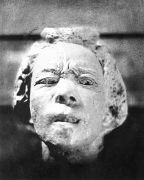 Between
1908 and 1911, Rodin created a series of 53 masks of the Japanese dancer
and actress Hanako; it was the largest number of portraits he ever made of
a single person. To explain why he was so fascinated with her appearance,
he told his friend Paul Gsell: Between
1908 and 1911, Rodin created a series of 53 masks of the Japanese dancer
and actress Hanako; it was the largest number of portraits he ever made of
a single person. To explain why he was so fascinated with her appearance,
he told his friend Paul Gsell:
"I have made a study of the Japanese actress,
Hanako. She has not a particle of fat.... Therefore she has an anatomy totally different from that of Europeans, but is
exceedingly beautiful in its unique strength.... Beauty is character and expression. The human body is, above all,
the mirror of the soul, from which the greatest beauty comes.... What we adore in the human body is definitely
more than its form, however beautiful; it is the flame that illuminates the body from within."
[Rodin in: Paul Gsell, Auguste Rodin - L'Art]
 In
1906, Hanako had danced at the Colonial Exhibition in Marseilles where Rodin
has seen her for the first time and was intensely interested in the tiny
dancer's fierce action in the death scene. The performance had been
co-ordinated by the American dancer Loïe Fuller, a friend of Rodin, who
had met the actress in 1904 or 1905 and given her the stage name 'Hanako',
meaning 'Little Flower'. It was also Loïe Fuller who introduced Hanako to
the sculptor, who by that time was plunging into the subject of dance,
especially its exotic forms, producing dozens of drawings of the Cambodian
dancers who performed in Marseille the same year. In
1906, Hanako had danced at the Colonial Exhibition in Marseilles where Rodin
has seen her for the first time and was intensely interested in the tiny
dancer's fierce action in the death scene. The performance had been
co-ordinated by the American dancer Loïe Fuller, a friend of Rodin, who
had met the actress in 1904 or 1905 and given her the stage name 'Hanako',
meaning 'Little Flower'. It was also Loïe Fuller who introduced Hanako to
the sculptor, who by that time was plunging into the subject of dance,
especially its exotic forms, producing dozens of drawings of the Cambodian
dancers who performed in Marseille the same year.
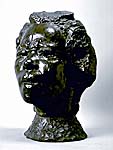 After leaving the stage in Marseille, Hanako came to Paris, where Rodin asked
her to become his model. In 1908 or 1907 - but maybe even as early as 1906
- he executed the first 'Mask of Hanako'.
In the following years, he continued making masks of the Japanese dancer, many of them
expressing death agony. Although the Kabuki Theatre with its
extensive repertoire of stylised facial expressions was closed to women
, Hanako doubtlessly was so familiar with the Japanese stage traditions
that she was able to control her body to the utmost and turn her own face
into a mask - a mask that the riddled sculptor in turn tried to scrutinize
for the human emotion behind it. In this sense, these 53 works not only are
masks: they deal with masks as such, with the possibility to transfer
emotion by means of a fixed outer appearance, and the limits of such an
effort.
After leaving the stage in Marseille, Hanako came to Paris, where Rodin asked
her to become his model. In 1908 or 1907 - but maybe even as early as 1906
- he executed the first 'Mask of Hanako'.
In the following years, he continued making masks of the Japanese dancer, many of them
expressing death agony. Although the Kabuki Theatre with its
extensive repertoire of stylised facial expressions was closed to women
, Hanako doubtlessly was so familiar with the Japanese stage traditions
that she was able to control her body to the utmost and turn her own face
into a mask - a mask that the riddled sculptor in turn tried to scrutinize
for the human emotion behind it. In this sense, these 53 works not only are
masks: they deal with masks as such, with the possibility to transfer
emotion by means of a fixed outer appearance, and the limits of such an
effort.
Who was Hanako?
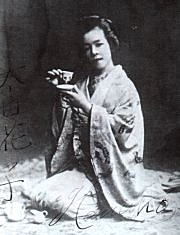 Hanako was born in 1868
in Kamisobue Village located on the River Kiso in the Aichi
Prefecture. Her real name was Hisa Ohta, but she was also known as Hisako
Hohta - a heroine from the play 'The Geisha's Vengeance'.
Hisa's parents, Hachiuemon Ohta and his wife Ume, were wealthy and had three sons and five daughters including
Hisa. Enthusiastic
for Japanese music and dance, they made extraordinary efforts in training
her and her four sisters even in their early childhood. As her parents
became faced with financial misery, Hisa moved to a foster family, till
her fosther father went into bankruptcy as well and left his home. At the age
of ten, Hisa participated in a travelling group of women-actresses, who
had noticed her dramatic skills. Hanako was born in 1868
in Kamisobue Village located on the River Kiso in the Aichi
Prefecture. Her real name was Hisa Ohta, but she was also known as Hisako
Hohta - a heroine from the play 'The Geisha's Vengeance'.
Hisa's parents, Hachiuemon Ohta and his wife Ume, were wealthy and had three sons and five daughters including
Hisa. Enthusiastic
for Japanese music and dance, they made extraordinary efforts in training
her and her four sisters even in their early childhood. As her parents
became faced with financial misery, Hisa moved to a foster family, till
her fosther father went into bankruptcy as well and left his home. At the age
of ten, Hisa participated in a travelling group of women-actresses, who
had noticed her dramatic skills.
At the age of 15, she entered a
short engagement as a Geisha, by that time a respectable way of receiving
training in song, dance, and shamisen playing. Her marriage was
confronted with financial desaster as well, as her husband spent all the
money they had saved and returned to his parents, who had always opposed
to the wedding.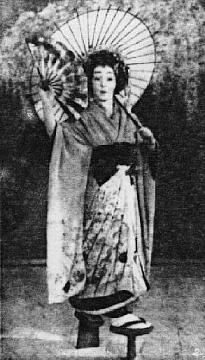 Left alone in Yokohama, she boarded a ship for Denmark in May 1902, to act
in a circus-like show in Copenhagen; subsequently, she organized her own group and toured
around Europe, at last with great success.
Left alone in Yokohama, she boarded a ship for Denmark in May 1902, to act
in a circus-like show in Copenhagen; subsequently, she organized her own group and toured
around Europe, at last with great success.
But not only in Europe Hisa's fame increased; after her
tour in Russia, the resonance for her dancing acts was overwhelming:
Small, comical, touching Hanako! I call on all the actresses of our decrepit stage to admire and learn from you, for you
never rely on 'clever' scripts or costly costumes or complicated sets, but only on your own arts, which are so
much fresher so truly theatrical, and so charmingly beautiful. Oh, how vulgar are the speech arts of our
actresses compared with yours! [Yevreinov]
The tiny Madame Hanako, with extraordinarily agile face
and body movements, acts truly with her whole being, to
the extreme ends of her miniature fingers and the action
of her flexible and expressive back.( Vasilevsky)
She showed such refinement of technique and control of her
reflex actions that, when she mimicked a cat, the pupils of her eyes
seemed to have dilated. [Meierkhol'd]
At the same time, traditional critics in Japan denounced Hanako's
performances, stating the fame of this self-made person in fact was a
shame for the nation.
In 1914, when the World War I broke out, Hanako
travelled to
London together with Rodin and Rose Beuret, where she had an engagement at
the Ambassadors Theatre. As it was getting more difficult to obtain stage
contracts, she opened a Japanese restaurant named "Kogetsu (Moon-Lake)" in Dorset Square,
London in
1917. Four years later, she returned to Japan for good.
According
to the promise Rodin made before he died, the French government sent two masks
after Hanako : 'Head of Death' and 'A
Meditating woman'. Within a short time, the returned model received demands of men of
letters and artists for having a look at these portraits; specialists and also
students from the Schools of Fine Art came to visit her and art dealers showed
active interest in purchasing the works. For Hanako, this growing interest
became increasingly disturbing - she feared the precious works might be
damaged. 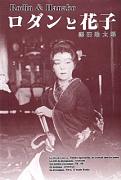
When the World War II broke out, France and Japan became
enemies. Any person dealing with France was easily branded as a traitor,
so that the popularity of the masks now turned into a risk for their
owner. The retired dancer found a safe place for them in the house of Dr. Hideo Akatsuka, artist and medical doctor,
where the masks remained intact till the end of the war. On 2 April 1945,
Hanako died at the age of 77, before her house was destroyed by an
American bomb. The masks are now kept in the Niigata City Art Museum.
[Biographical information summarized from the book 'Rodin
and Hanako" by Sawada Suketaro, son-in-law of Hanako's adopted son.]
BIBLIOGRAPHY (supplied by The
National Gallery of Art, Washington):
 Cladel, Judith. Rodin:
The Man and His Art. Trans. S.K. Star. New York, 1917: 161-165. Cladel, Judith. Rodin:
The Man and His Art. Trans. S.K. Star. New York, 1917: 161-165.
 Grappe, Georges.
Catalogue du Musée Rodin. Paris, 1927: 97. Grappe, Georges.
Catalogue du Musée Rodin. Paris, 1927: 97.
 Grappe, Georges.
Catalogue du Musée Rodin. 5th ed. Paris, 1944: 123-124. Grappe, Georges.
Catalogue du Musée Rodin. 5th ed. Paris, 1944: 123-124.
 Keene, Donald.
"Hanako." New Japan 14 (1962): 125-127. Keene, Donald.
"Hanako." New Japan 14 (1962): 125-127.
 Spear, Athena Tacha.
Rodin Sculpture in the Cleveland Museum of Art. Cleveland, 1967: 32-37,
93-94. Spear, Athena Tacha.
Rodin Sculpture in the Cleveland Museum of Art. Cleveland, 1967: 32-37,
93-94.
 Tancock, John. The
Sculpture of Auguste Rodin. Philadelphia, 1976: 546-551. Tancock, John. The
Sculpture of Auguste Rodin. Philadelphia, 1976: 546-551.
 de Caso, Jacques, and
Patricia B. Sanders. Rodin's Sculpture: A Critical Study of the Spreckels
Collection. San Francisco, 1977: 304-309. de Caso, Jacques, and
Patricia B. Sanders. Rodin's Sculpture: A Critical Study of the Spreckels
Collection. San Francisco, 1977: 304-309.
 Judrin, Claude. Rodin
et l'Extrême-Orient. Exh. cat. Musée Rodin, Paris, 1979: 23-43. Judrin, Claude. Rodin
et l'Extrême-Orient. Exh. cat. Musée Rodin, Paris, 1979: 23-43.
 Rodin Rediscovered.
Exh. cat. National Gallery of Art, Washington, D.C., 1981: 232-233. Rodin Rediscovered.
Exh. cat. National Gallery of Art, Washington, D.C., 1981: 232-233.
 Suketaro, Swada.
Little Hanako. Nagoya, 1984. Suketaro, Swada.
Little Hanako. Nagoya, 1984.
 Grunfeld, Frederic V.
Rodin: A Biography. New York, 1987: 521-522. Grunfeld, Frederic V.
Rodin: A Biography. New York, 1987: 521-522.
 Beausire, Alain. Quand
Rodin Exposait. Paris, 1988: 320, 323, 336, 367. Beausire, Alain. Quand
Rodin Exposait. Paris, 1988: 320, 323, 336, 367.
 Butler, Ruth, and
Suzanne Glover Lindsay, with Alison Luchs, Douglas Lewis, Cynthia J.
Mills, and Jeffrey Weidman. European Sculpture of the Nineteenth Century.
The Collections of the National Gallery of Art Systematic Catalogue.
Washington, D.C., 2000: 392-394, color repro. Butler, Ruth, and
Suzanne Glover Lindsay, with Alison Luchs, Douglas Lewis, Cynthia J.
Mills, and Jeffrey Weidman. European Sculpture of the Nineteenth Century.
The Collections of the National Gallery of Art Systematic Catalogue.
Washington, D.C., 2000: 392-394, color repro.
|